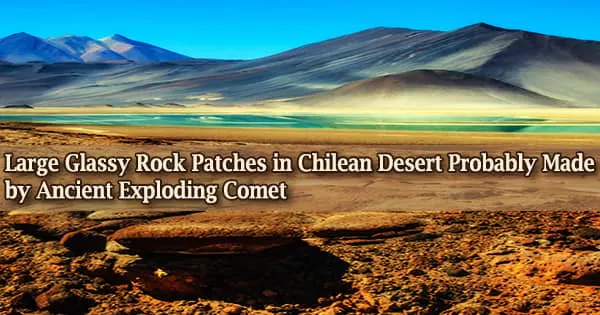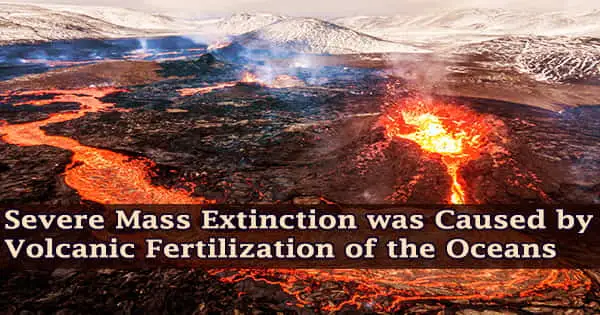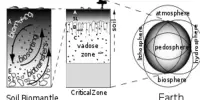A large portion of Chile’s the Atacama Desert was burnt approximately 12,000 years ago by an extreme heat source that transformed the sand into broad slabs of silicate glass. A research team that has been examining the distribution and makeup of those glasses has now made a determination as to what started the inferno.
Researchers have demonstrated that samples of the desert glass contain minute pieces with minerals often seen in rocks with extraterrestrial origins in a study that was published in the journal Geology. Those minerals closely match the make-up of material that NASA’s Stardust mission, which collected dust from the comet known as Wild 2, returned to Earth.
The research team comes to the conclusion that those mineral assemblages are probably the ruins of an extraterrestrial object, most likely a comet with a composition similar to Wild 2, which streamed down after the explosion that melted the sandy surface below.
“This is the first time we have clear evidence of glasses on Earth that were created by the thermal radiation and winds from a fireball exploding just above the surface,” said Pete Schultz, a professor emeritus in Brown University’s Department of Earth, Environmental and Planetary Sciences.
“To have such a dramatic effect on such a large area, this was a truly massive explosion. Lots of us have seen bolide fireballs streaking across the sky, but those are tiny blips compared to this.”
The Atacama Desert east of Pampa del Tamarugal, a plateau in northern Chile sandwiched between the Andes Mountains to the east and the Chilean Coastal Range to the west is covered in patches with the glasses.
Fields of dark green or black glass can be found in a 75-kilometer corridor. According to Schultz, the glasses’ origin has been a mystery because there is no proof that they could have been produced by volcanic activity.
This is the first time we have clear evidence of glasses on Earth that were created by the thermal radiation and winds from a fireball exploding just above the surface. To have such a dramatic effect on such a large area, this was a truly massive explosion. Lots of us have seen bolide fireballs streaking across the sky, but those are tiny blips compared to this.
Professor Pete Schultz
Due to the fact that the area wasn’t always desert, some scholars have hypothesized that the glass was produced by long-ago grass fires. It has been hypothesized that extensive fires may have burnt hot enough to melt the sandy soil into enormous glassy slabs during the Pleistocene epoch when rivers from mountains to the east created oases with trees and grassy wetlands.
However, the new study discovered that simple fires are an impossibility as a production method due to the amount of glass present and a number of important physical features. The glasses display signs of having been bent, rolled, folded, and even tossed while they were still molten.
That is compatible with a huge meteor impact and airburst explosion, which would have been followed by winds with a tornado force. According to Schultz, the mineralogy of the glass seriously calls into question the grassfire theory.
Schultz and colleagues conducted a thorough chemical study of dozens of samples taken from glass formations throughout the region, working with scientists from the Fernbank Science Center in Georgia, Chile’s Universidad Santo Tomás, and the Chilean Geology and Mining Service.
The investigation uncovered zircon minerals that had formed baddeleyite through heat decomposition. According to Schultz, that mineral transformation normally takes place at temperatures higher than 3,000 degrees Fahrenheit, which is much hotter than what might be produced by grass fires.
According to the researchers, the examination also uncovered collections of unusual minerals that are only present in meteorites and other extraterrestrial rocks. Specific minerals like troilite, cubanite, and inclusions rich in calcium and aluminum matched the mineral signatures of comet samples found by NASA’s Stardust mission.
“Those minerals are what tell us that this object has all the markings of a comet,” said Scott Harris, a planetary geologist at the Fernbank Science Center and study co-author. “To have the same mineralogy we saw in the Stardust samples entrained in these glasses is really powerful evidence that what we’re seeing is the result of a cometary airburst.”
According to Schultz, more research is required to ascertain the specific ages of the glass, which would provide the precise time the event occurred. However, the hazy timing places the impact exactly around the period that big mammals vanished from the area.
“It’s too soon to say if there was a causal connection or not, but what we can say is that this event did happen around the same time as when we think the megafauna disappeared, which is intriguing,” Schultz said. “There’s also a chance that this was actually witnessed by early inhabitants, who had just arrived in the region. It would have been quite a show.”
Schultz and his team are hoping that additional study will help to limit the timeframe and clarify the extent of the impactor. For the time being, Schultz hopes that this study will aid in the identification of other blast sites and the disclosure of the possible risk posed by such occurrences.
“There may be lots of these blast scars out there, but until now we haven’t had enough evidence to make us believe they were truly related to airburst events,” Schultz said. “I think this site provides a template to help refine our impact models and will help to identify similar sites elsewhere.”
Other authors of the study were Sebastian Perroud, Nicolas Blanco, and Andrew Tomlinson.
















